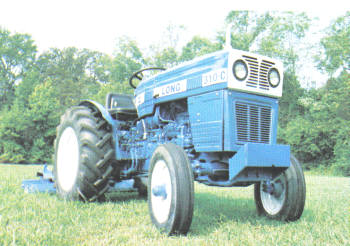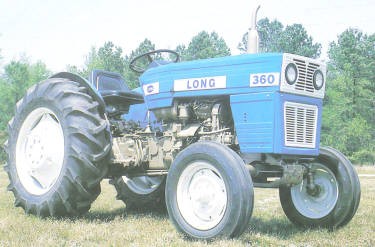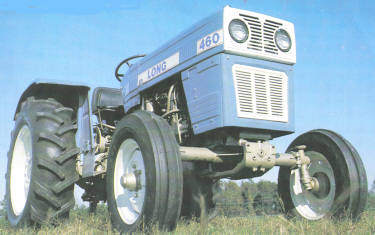Long Tractors

The Long 260-C

The 'next generation' of Long tractors began--at the bottom end-- with the 260-C, the "C" standing for "Compact".
A compact tractor--for using full-sized components--the 260-C was, for it, owing to it's short, 2 cylinder engine, was only justover 9 feet long from the leading edge of the front tires to the trailing edge of the rear tires, and only 64.4 inches wide at it's widest tire setting, and as narrow as 54.4 inches. Differing from the larger models in the current and earlier series, the 260-C had only 4 track width adjustments, rather than 8.

Sharing a common 95MM X 110MM bore and stroke with several of it's larger stablemates, the two cylinder format provided the 260-C with a Liliputian 95 cubic inch displacement. PTO horsepower from this little engine was rated at 24, at it's rated engine speed of 2400RPM. As with all the larger tractors in this new series, the 260-C was water cooled, under a 4PSI radiator cap calibration. Lubrication was full-flow, with a spin-on, disposable oil filter. Starting was aided on cool mornings by a thermostarter system.
Like the earlier 350 and 445, the 260-C had a 6 speed forward, 2 speed reverse, partially synchronized, dual range transmission, all controlled through one auto-locking shift lever. 6th-to-5th, and 3rd-to-2nd downshifts were synchronized. No differential lock was offered on the 260-C.
PTO-driven implements were easily contolled by the 260-C's two stage, 10 inch clutch. 540 RPM or ground speed could be selected on the same lever. As in all UTB-built Long tractors, 540 RPM speed was achieved at 1970 engine RPM. Like the 350 an engine speed DTO (Direct Power Takeoff) was also included in the package.
Braking on the 260-C was accomplished through 50MM width, dry, contracting band brakes, around a drum mounted on the axle shaft to the outboard final drives. They could be locked together for simultaneous use, or used individually for assisting maneuverability in tight quarters. A hand operated, ratcheting parking brake was standard equipment for the 260-C, and was applied to both brake pedals.
The 260-C utilized a 5.75GPM hydraulic pump, for a huge 2660 pounds lift rating on the standard equipment, draft sensing three point hitch. Front end 'suitcase' weights of 75 pounds apiece were optionally available to take advantage of this lift capacity in such a small tractor.
Steering was manual, or, optionally, hydrostatic power steering (as opposed to the earlier 350 & 445, which only had power assisted steering as an option) was available, but factory installed only.
The front axle on the 260-C was a narrower version of the front axle on the earlier 350, 445, and 550 tractors. Front and rear track adjustments were a narrow 40-52 inches, allowing the 260-C to work in very narrow confines indeed; it's very design made it a 'perfect fit' for vineyard use.
Tire equipment on the 260-C was 5.00x15 front, and 12.4x24 rear; both smaller than the prior 350 tractor. The 260-C was only available as a 2 wheel drive unit. Turf or Ag style tires were at the discretion of the buyer. Shipping weight was 3180 pounds; suprizing for such a small tractor, but make sense upon the consideration of the 260-C being basically a restyled 350, with only one engine cylinder lopped off.
Sheet metal styling of the 260-C imitated the Long 550, in that it shared the same lower grille, side panels, and fuel tank cover and instrument panel pod as the larger tractor. In a minor departure from the larger 550's styling, the 260-C had no outboard headlights, but relocated them into the upper grille panel, which was restyled for that purpose. Owing to the 2 cylinder engine in the 260-C, it's hood was shortened to suit. Owing to the 24 inch rear wheel size, the 260-C had smaller radius fenders than the 350, to closer hug it's smaller rear tires.
The 260-C was rather well equipped for a small tractor, lacking only a differential lock. Regular equipment included live PTO, hand and foot throttles, full instrumentation, headlights, and thermostarter. A drawbar was only optional, however, as was a remote outlet for double-acting hydraulic cylinders, or reversable hydraulic motors. An underslung muffler was also an available option on the 260-C.

Other than the decals, looking exactly like the 260-C, the Long 310-C differed only in a larger 102MM bore in the engine cylinders, compared to the 260-C's smaller 95MM bore. This bore difference gave the 310-C a 109.7 cubic inch displacement, and a 4 PTO horsepower increase over the 260-C, resulting in 28 PTO HP at 2400 RPM.
All other equipment and specifications were exactly the same as the 260-C.

Having much the same performance specifications as the 310-C was the 310, but in a full size format. Narrowest setting of the rear wheels was 58.2 inches overall, and 61.57 inches on the front, overall. As in the larger tractors, there were 8 different track setting positions on the 310, as opposed to the more limitied 4 settings on the 310-C and 260-C.
Differing from the 310-C were the tire sizes on the 310. Front tires were the same, but rear tire size was 11.2x28, ag style only; turf tires weren't officially offered. Larger radius shell fenders were included standard on the 310 to better protect the operator from the larger diamter rear tires.
Options were more generous for the 310 than the 310-C and 260-C; added was a two post ROPS (Roll Over Protective Structure) and seat belt, and a FOPS (Falling Object Protective Structure) canopy. Also available were a heavier duty battery, and wheel spacers. Owing to it's 'compact tractor', and 'hobby farmer' status, a drawbar was still optional equipment on the 310.
A big departure from the 310-C to the 310 was the DT option--Dual Traction, or 4 wheel drive. This added a 40% tractive effort increase over the 2 wheel drive 310's ability in loose footing. This was a welcome option for loader work.

Stepping out of the 310's 'compact tractor' market, and into the 'utility tractor' market, was the Long 360. Basically a restyled Long 350, the Long 360 was rated at 35 PTO horsepower, rather than the 32 PTO HP of the 350. This extra power was owed to a higher delivery setting in the 360's fuel injection pump.
Differing from the earlier 350, the Long 360 provided headlights as standard equipment, installed in the upper part of it's restyled grille.
The 360 developed it's horsepower from a 3 cylinder, liquid cooled, direct injection, 4 main bearing, Diesel engine of 143 cubic inches. Maximum operating speed was 2400RPM, like most of it's stablemates. Full filtration was provided, in a spin-on, disposable oil filter, and an oil bath air cleaner, with a cyclonic precleaner, limiting air cleaner oil changes to only once a year, or when sediment in the oil cup reach 1.3 inches in depth; whichever came first.
Behind the 360's reliable, efficient engine was a dry, 10 inch, two stage clutch, providing a live PTO at the rear of the now-familiar 6 speed forward, 2 speed reverse transmission, with outboard final drives, and dry, 50MM dry contracting band/internal drum, brakes. Like the earlier 350, the 360 offered a parking brake only as an optional accessory.
The 8 position, round tube telescoping front axle re-appeared under the 360. Steering arms were the same as all the aforementioned Long/Universal tractors, and manual steering was still an option; power assisted steering was available as an option. This was on the early model 360 tractors. The power steering system was the left side-mounted, drag link, actuating valve unit as was available on the earlier 350 and 445 tractors; hydrostatic power steering became standard equipment on later 360 tractors.
While ROPS and FOPS weren't offered on earlier 360 tractors, those options were added later on in the 360's production run. A ROPS-style cab was even made available on special order; these likely became popular with county and city services for snow removal and salt applicating units.

A big brother to the 360 was the Long 460, and four wheel drive 460DT. Turning up the injection pump from the setting provided in the 360 netted the 460 with a 41.93 PTO horsepower rating. All other aspects of the 3 cylinder, liquid cooled, direct injection, 4 main bearing, 143 cubic inch, 2400 RPM rated speed Uzina D115 engine remained the same. Power transmission to the ground and out the PTO was sent through the 460's 10, two stage clutch, on through the single stick, 6 speed forward, 2 speed reverse, partially synchronized transmission, with it's lockable, bevel gear differential, and out the spur gear final drives to the wheels. Final reduction was a deep 5.636:1, as in all prior UTB tractors sold by Long.
A later edition of the Long 460 was equipped with the same 8 speed forward, 2 speed reverse, partially synchronized, independant PTO transmission of the larger 550/560 tractors. This was a welcome improvement in a small, 42 horsepower, 3 cylinder utility tractor.
Hydraulics on the 460 consisted of a 5.75GPM, timing case mounted pump, running in a closed center system, to a draft and position control Cat I & II three point hitch, resulting in a lift capacity of 2660 pounds, at the factory relief valve setting of 2133 pounds per square inch pressure.
As in the other contempoary, utility-sized Long/UTB tractors, the 460 had an 8 position round tube, telsecopic round axle, giving tread settings from a minimum of 50 3/8 inches, out to a maximum tread setting of 77½ inches. Rear tread was adjustable from a minimum setting of 47¼ inches, out to a maximum setting of 74 13/16 inches.

Differing in front wheel track adjustability was the Long 460DT; it had a non-adjustable, offset differential, non-planetary reduction, driven front axle. The only tread setting for the 460DT's front axle was 59½ inches. Rear tread setting on the 460DT remained the same as the 2 wheel drive 460. The front axle was driven from a transfer case under the left floorboard of the tractor, and the driveshaft ran along the left side of the engine; these were called 'side drive' front axles.
Front and rear wheel equipment for the 460 was 6.00x16, 3 rib, 4 ply front tires, and 13.6x28 4 ply rear tires, on NPA wheels, with 13.6x28 6 ply, or 14.9x28 4 ply tires optional. Power adjustable rear wheels were an option. No optional tire sizes were available on the 460DT; only 7.50x20 ag grip front tires, and 13.6x28 rears, to maintain the correct ratio between the front and rear differentials.
Sheet metal styling on the 460 and 460DT was exactly the same as on the smaller 360, but for one difference: the 460 and 460DT were provided with the same wide, semi-rounded, flat top fenders as the earlier 550, affording the operator full isolation from the rear tires. A 2 post ROPS was optionally available, but no FOPS was officially available, although the same one from the 360 tractor would fit. As on the smaller 360, a ROPS cab was available on special order.
Standard equipment on the 460 and 460DT consisted of a thermostarter system, oil bath air cleaner with precleaner, hand and foot throttles, parking brake, differential lock, drawbar (elevating the 460/460DT to full working tractor status), full instrumentation in the new style higher position, and headlights. Optional was power steering (when so equipped, the power steering pump was mounted on the opposite side of the timing case from the hydraulic pump, and driven by the same gear), consisting of the left side mounted, drag link style, actuating valve cylinder identical to that used on the 350, 360, 445, and 550 tractors. Also optional were wheel spacers and a remote hydraulic outlet, consisting of a center detent valve, hoses, and fittings.